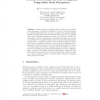Free Online Productivity Tools
i2Speak
i2Symbol
i2OCR
iTex2Img
iWeb2Print
iWeb2Shot
i2Type
iPdf2Split
iPdf2Merge
i2Bopomofo
i2Arabic
i2Style
i2Image
i2PDF
iLatex2Rtf
Sci2ools
AVBPA
2001
Springer
2001
Springer
A Multi-view Method for Gait Recognition Using Static Body Parameters
A multi-view gait recognition method using recovered static body parameters of subjects is presented; we refer to these parameters as activity-specific biometrics. Our data consists of 18 subjects walking at both an angled and frontal-parallel view with respect to the camera. When only considering data from a single view, subjects are easily discriminated; however, discrimination decreases when data across views are considered. To compare between views, we use ground truth motioncapture data of a reference subject to find scale factors that can transform data from different views into a common frame (“walking-space”). Instead of reporting percent correct from a limited database, we report our results using an expected confusion metric that allows us to predict how our static body parameters filter identity in a large population: lower confusion yields higher expected discrimination power. We show that using motion-capture data to adjust vision data of different views to a comm...
| Added | 28 Jul 2010 |
| Updated | 28 Jul 2010 |
| Type | Conference |
| Year | 2001 |
| Where | AVBPA |
| Authors | Amos Y. Johnson, Aaron F. Bobick |
Comments (0)

